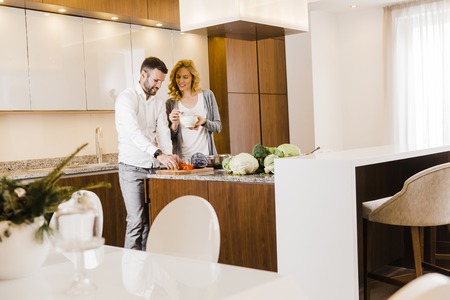Introduction to the Fusion of Traditional British Architecture and Feng Shui
The architectural landscape of the United Kingdom is renowned for its rich heritage, with styles ranging from the grandeur of Georgian townhouses and the charm of Victorian terraces to the sturdy elegance of Tudor cottages. This deep-rooted architectural tradition forms an essential part of British identity, influencing not only the exterior facades but also the way interiors are conceived and utilised. In recent years, there has been a noticeable shift towards integrating global design philosophies into these time-honoured structures, particularly Eastern concepts such as Feng Shui. This trend is especially evident in contemporary kitchen design, where homeowners seek to marry the historic character of their homes with modern principles that promise enhanced wellbeing and functionality. As more Britons embrace open-plan kitchens and flexible living spaces, interest in harmonising traditional British elements with Feng Shui’s focus on energy flow, balance, and practicality continues to grow. This convergence offers a unique opportunity to reimagine how classic architecture can coexist with, and even be revitalised by, holistic Eastern practices.
2. Key Elements of Traditional British Architecture Relevant to Kitchens
When seeking to blend modern Feng Shui kitchen principles with the essence of traditional British architecture, it is essential to first identify and understand the hallmark characteristics that define a classic British kitchen. These elements not only contribute to the space’s aesthetic appeal but also influence its functionality and overall atmosphere—a crucial consideration when integrating Feng Shui concepts.
Hallmark Features of Classic British Kitchens
The following features are central to traditional British kitchen design, each with unique cultural significance and practical implications for spatial flow, light, and harmony:
| Feature | Description | Relevance to Feng Shui |
|---|---|---|
| Exposed Beams | Visible wooden beams—often oak—are a signature element in period homes, evoking a sense of history and rustic charm. | Encourages grounded energy; beams should be balanced to avoid oppressive or heavy atmospheres above key work areas. |
| Sash Windows | Vertically sliding windows allow for flexible ventilation and natural light, typical in Georgian and Victorian properties. | Supports healthy qi flow by maximising daylight and fresh air, crucial for vibrant kitchen energy. |
| Aga Cookers | A cast-iron range cooker, often the focal point of the British country kitchen, symbolises warmth and hospitality. | Acts as a fire element; proper placement is vital to ensure balance with water elements (e.g., sinks), aligning with Feng Shui principles. |
| Butler Sinks | Deep ceramic sinks are both practical and iconic, reflecting utility and tradition. | Relates to the water element; their position influences nourishment and household prosperity according to Feng Shui. |
| Pine Dressers & Larders | Freestanding wooden storage units showcase crockery while offering ample storage—a nod to cottage-style living. | Contributes to organisation and clutter-free surfaces, supporting smooth qi circulation throughout the space. |
| Tiled or Flagstone Floors | Durable stone or ceramic floors are common in older homes, adding tactile character underfoot. | Represents earth elements; promotes stability but should be balanced with softer textures for harmonious energy. |
Cultural Resonance: Why These Features Endure
The enduring popularity of these architectural details lies in their ability to create a kitchen environment that feels both welcoming and functional—a space where tradition meets daily life. Their inherent qualities align surprisingly well with many Feng Shui ideals: openness, balance between elements, and an emphasis on natural materials. By recognising these features as foundational, homeowners can more thoughtfully overlay modern Feng Shui strategies without sacrificing authenticity or local character.

3. Core Concepts of Modern Feng Shui in Kitchen Design
When seeking harmony between traditional British architecture and modern Feng Shui kitchen principles, it is crucial to grasp the foundational concepts that underpin a balanced and energised cooking space. At the heart of Feng Shui lies the notion of energy flow—referred to as Qi—which must circulate freely throughout the kitchen. In older British homes, where kitchens often feature distinctive layouts and period details, careful consideration is needed to ensure that these spaces do not impede the natural movement of Qi.
Qi Flow and Spatial Orientation
One of the most significant aspects of Feng Shui in kitchen design is promoting an unobstructed flow of energy. For example, avoid placing the cooker directly opposite the back door or under a low beam, as this can cause energy to escape or stagnate. In many classic British homes, kitchens might be set at the rear or side of the property; thus, arranging pathways and cabinetry to maintain open sightlines becomes essential for fostering positive Qi movement.
Positioning of Cooker and Sink
Feng Shui also emphasises the relationship between fire (the cooker) and water (the sink). Ideally, these two elements should not be positioned directly opposite or beside each other, as this can create disharmony and tension within the household. In Victorian or Edwardian kitchens with their characteristic alcoves and hearths, it may be necessary to thoughtfully adapt layouts so that cookers and sinks are separated by counter space or placed at right angles. This balance supports both the practical workflow and energetic equilibrium.
Clutter Management for Well-being
Another core principle is clutter management. British homes are often celebrated for their cosy character but can suffer from limited storage in kitchen areas. Clutter disrupts Qi flow and can undermine feelings of calm and efficiency. Integrating smart storage solutions—such as concealed cabinetry or multi-functional islands—can help maintain the visual simplicity prized by both Feng Shui and traditional British aesthetics. By keeping worktops clear and maintaining orderly cupboards, residents invite prosperity and well-being into the home while respecting architectural heritage.
4. Reconciling Architectural Character with Feng Shui Principles
Integrating traditional British kitchen features with modern Feng Shui principles requires a careful balance between preserving architectural character and achieving harmonious energy flow. British kitchens often display robust cabinetry, deep-set windows, and characteristic Aga cookers—features steeped in historical and cultural value. However, these elements may sometimes clash with Feng Shui recommendations, such as maximising natural light, ensuring unobstructed pathways, or utilising particular materials and colour palettes. Below is an analysis of key areas where adaptation is possible while maintaining the essence of British design:
Retaining Heritage Features While Enhancing Energy Flow
Traditional British kitchens are known for their solid wood finishes, exposed beams, and compartmentalised layouts. Modern Feng Shui advocates for open spaces and smooth circulation. By selectively opening up sections (for example, removing upper cabinets between kitchen and dining areas), one can foster better Chi flow without stripping away period charm. Consider integrating glass-fronted cabinetry or open shelving to lighten visual heaviness while still honouring original joinery styles.
Optimising Natural Light Without Altering Window Character
Deep-set sash or casement windows are hallmarks of British architecture but may limit daylight penetration—contrary to Feng Shui’s preference for bright, uplifting environments. Solutions include using lighter window dressings or adding reflective surfaces (such as splashbacks in soft metallic tones) that amplify existing light. This approach respects window heritage while fulfilling Feng Shui’s call for luminosity.
Material and Colour Adaptation: Harmonising Old with New
While British kitchens favour muted hues—sage green, navy blue, cream—modern Feng Shui may recommend earth tones or pastels to enhance warmth and grounding. A compromise can be achieved by incorporating subtle accents: soft gold handles, pastel-coloured accessories, or natural stone worktops. The table below outlines practical adaptations:
| Traditional Feature | Feng Shui Challenge | Adaptation Strategy |
|---|---|---|
| Heavy Timber Cabinets | Energy stagnation | Add open shelving or glass panels; use lighter wood stains |
| Compartmentalised Layouts | Poor Chi circulation | Create partial openings; use archways or interior windows |
| Sash/Casement Windows | Limited natural light | Lighter curtains; add mirrors or glossy finishes opposite windows |
| Aga Cooker Placement | Poor fire element positioning | Ensure cooker faces a supporting wall; avoid direct alignment with sinks/doors |
| Muted Colour Palette | Lack of vibrancy/grounding | Add earth-tone décor; incorporate live plants or warm lighting |
Cultural Integrity: Avoiding Over-Modernisation
The integration process should not result in the erasure of British character. By focusing on reversible enhancements—such as portable screens to redirect energy flow or non-permanent lighting solutions—it is possible to experiment with Feng Shui without undermining historic value. Consulting local artisans can also ensure that any modern interventions are sympathetic to traditional craftsmanship.
Conclusion: A Thoughtful Synthesis
Reconciling traditional British architectural elements with modern Feng Shui kitchen principles involves thoughtful analysis and sensitive adaptation. Through minor structural changes, selective material choices, and respect for both cultures’ values, it is entirely feasible to create a kitchen space that feels authentically British yet energetically balanced according to contemporary Feng Shui practices.
5. Practical Strategies and Local Examples
When integrating the aesthetic of traditional British architecture with the guiding principles of modern Feng Shui in kitchen design, a set of practical strategies can help homeowners achieve a harmonious balance. Below, we explore specific approaches—supported by local case studies—to demonstrate how these seemingly disparate influences can work together within the context of the UK.
Colour Selection: Embracing Heritage Palettes with Feng Shui Intent
Classic British homes often feature muted, earthy tones such as sage green, navy blue, or soft greys, reflecting both historical sensibilities and the local landscape. According to Feng Shui, colours in the kitchen should foster nourishment and energy flow; thus, introducing warm neutrals or gentle greens not only respects British tradition but also aligns with Feng Shui’s Wood and Earth elements for growth and stability. For instance, a restored Georgian townhouse in Bath incorporated deep olive cabinetry with brass accents—achieving a calm yet lively environment that enhances both heritage charm and energetic harmony.
Layout Adaptation: Merging Functionality with Flow
Traditional British kitchens were typically compact and separated from living spaces, whereas modern Feng Shui encourages open layouts to promote Qi circulation. Adapting this can involve removing non-structural partitions or widening doorways to create visual connectivity while retaining period features like cornices or original fireplaces. A Victorian terrace renovation in North London exemplifies this approach; designers opened up the kitchen to an adjacent dining area, maintaining stained-glass windows and tiled floors while orienting the cooker away from direct alignment with doors—a key Feng Shui consideration.
Material Choices: Authenticity Meets Energy Balance
Natural materials such as oak worktops, slate flooring, or Belfast sinks are hallmarks of British kitchens. From a Feng Shui perspective, these organic elements ground the space and support healthful energy. In a Cotswolds cottage conversion, for example, reclaimed timber beams were left exposed above a modern induction hob setup—blending rustic authenticity with contemporary efficiency and ensuring elemental balance within the heart of the home.
Case Study Spotlight: The Hampstead Heath Home
This Edwardian semi-detached house serves as a benchmark for successful integration. The kitchen features soft duck-egg blue cabinetry (a nod to both British heritage and Feng Shui’s Water element), open shelving to avoid stagnant corners, and strategically placed mirrors to reflect natural light into darker alcoves. These deliberate choices enhance both historic character and energy flow—offering a blueprint for those seeking inspiration rooted in real British homes.
Together, these strategies illustrate that harmonising traditional British architectural features with modern Feng Shui kitchen principles is not only feasible but can result in highly liveable and culturally resonant spaces. By drawing on local precedents and adapting time-honoured elements through a contemporary lens, homeowners can achieve an environment that nurtures both body and spirit.
6. Challenges and Considerations Unique to the UK Context
Integrating modern Feng Shui kitchen principles within traditional British architecture presents a unique set of challenges, many of which are distinct to the UK’s historical and environmental landscape. Understanding these constraints is essential for achieving a harmonious and practical balance between cultural design philosophies.
Listed Building Status and Planning Regulations
One of the foremost considerations in the UK is the prevalence of listed buildings, especially in heritage-rich areas such as London, Bath, or Edinburgh. Properties with listed status are subject to strict regulations that limit alterations to both their exteriors and interiors. This can pose significant hurdles when attempting to reposition kitchens or introduce structural changes like new doorways or expanded windows—alterations often recommended in Feng Shui practice for optimal energy flow and natural light.
Spatial Limitations in Traditional Homes
Traditional British homes, particularly Victorian terraces and Georgian townhouses, typically feature compact rooms and narrow corridors. Kitchens may be confined to small, enclosed spaces at the rear of the property, limiting options for reconfiguration or open-plan layouts favoured in contemporary Feng Shui kitchen design. These spatial constraints require creative solutions, such as maximising existing light sources or employing reflective surfaces to encourage chi (energy) circulation without extensive renovations.
The Influence of the British Climate
The British climate—characterised by frequent overcast skies and high humidity—also impacts the integration process. Limited sunlight may challenge efforts to ensure adequate natural illumination, a core element of Feng Shui kitchen principles. Furthermore, ventilation requirements differ from those in warmer climates; maintaining warmth while ensuring proper airflow can necessitate bespoke solutions such as advanced extractor systems or strategically placed windows that comply with both building standards and Feng Shui guidelines.
Cultural Compatibility and Practical Adaptation
Finally, any integration must consider local cultural sensibilities. British homeowners may prioritise preserving original features like fireplaces, sash windows, or Aga cookers, which may not always align neatly with Feng Shui recommendations. Successful projects often involve adaptive strategies—such as subtle colour adjustments or strategic furniture placement—that respect both tradition and contemporary wellbeing principles.
Conclusion
While integrating modern Feng Shui kitchen principles into traditional British architecture involves navigating regulatory frameworks, spatial limitations, climatic factors, and cultural expectations, thoughtful planning and adaptive design can bridge these challenges. The result is a kitchen space that respects Britain’s architectural heritage while promoting balance and wellbeing according to Feng Shui philosophy.
7. Conclusion: Creating Kitchens That Marry Heritage with Harmony
In summary, the thoughtful integration of traditional British architectural elements with modern Feng Shui kitchen principles opens up a unique pathway for homeowners seeking both cultural resonance and energetic balance. By respecting the rich heritage found in features such as sash windows, exposed beams, and classic stone or brickwork, one preserves the distinct character that defines British homes. When these cherished features are harmonised with Feng Shui’s guidance on spatial flow, light, colour, and placement, the kitchen transforms into a space that not only honours tradition but also enhances wellbeing. This marriage between old and new creates kitchens that feel both grounded in history and vibrant with positive energy. The result is a truly British kitchen—one where every detail is carefully considered to foster harmony, functionality, and a sense of belonging. Ultimately, blending these two worlds allows residents to enjoy an environment that reflects their identity while promoting comfort and prosperity for all who gather there.


